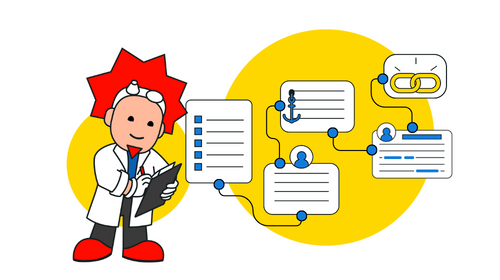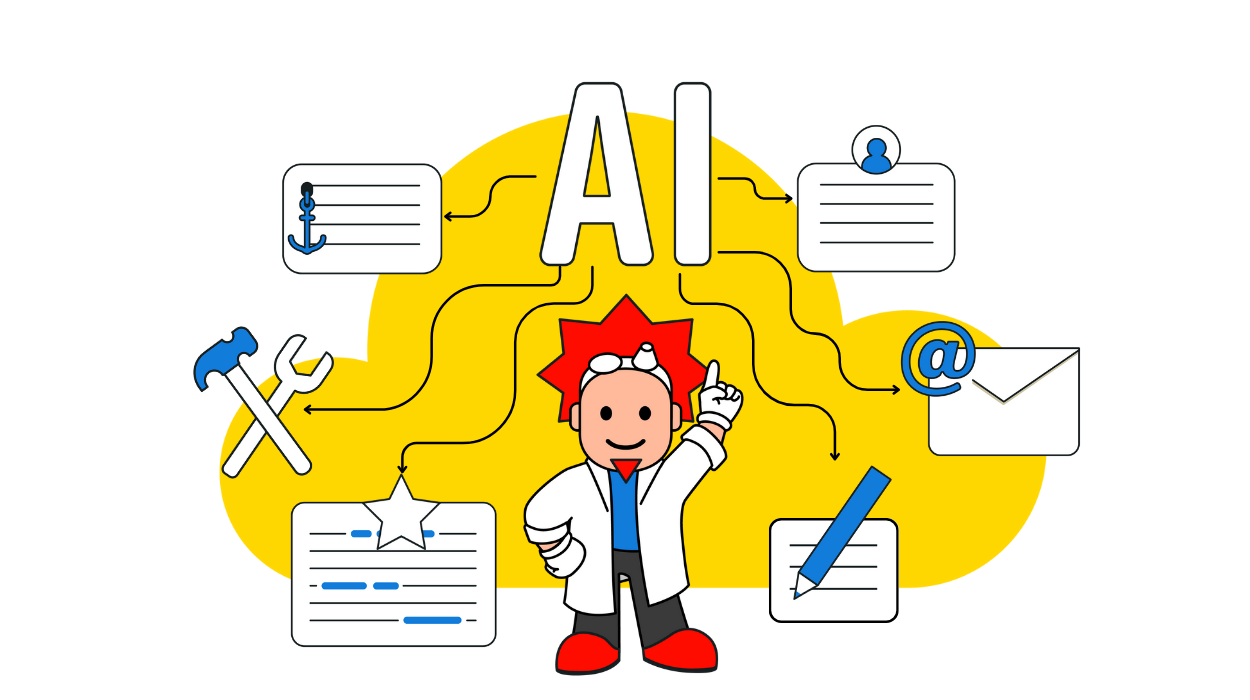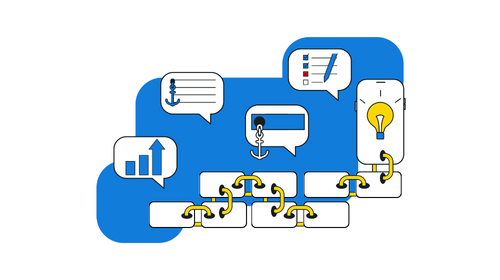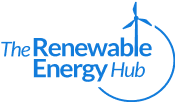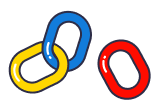In 2022, few things are more complicated or frustrating than cracking the ever-changing code to successful SEO.
Especially when it pertains to anchor text strategy.
Back in the “Glory Days” of SEO when keyword stuffing, comment spamming, and link schemes were as common as guest posting, link baiting, and booty pics on Instagram are today… anchor text strategy was simple.
You built a metric crap ton of exact match anchors in your blog article, linked them to a relevant asset, and voila! SEO juice for days.
In 2012 the first iteration of Google’s Penguin update changed that.
The exact strategies that worked only moments before the update went live will now get your site penalized into the stone age.
Exact match anchors were shunned and unnatural backlink profiles were targeted and brought down en masse, leading to widespread panic among formerly successful SEOs.
While many webmasters recovered from the update, many more did not.
Over the following years this trend was strengthened as Google rolled out updates like Panda, Hummingbird, and Penguin 4.0.
Although these updates improved the value and efficacy of their algorithm, it also had the unintended consequence of making it more difficult for honest marketers to answer the question, “What in the hell are we supposed to do?”
Don’t worry…
Even though there are more than 200 factors Google uses to determine who should rank #1, SEO can be simplified.
Although agencies and freelancers will talk a big game about how “difficult” SEO is and how complicate their strategies are… typically (although not always), this dribble is little more than sales-driven hyperbole designed to scare unsuspecting entrepreneurs into paying huge fees.
To make matters even worse, the court of public opinion seems to have reached the verdict that any anchor text optimization is considered “spammy” and should be avoided at all costs.
If you check forums or read most anchor text guides you get varying opinions.
For example, if you take a cursory glance at the Reddit SEO thread, you’ll likely see something like this…
Question : Hi, I’m building some links and wondering what I should do for anchor text. Any ideas?
95% of Answers : If you’re building links or optimizing anchor text, you are a spammer and Google should destroy your site and demolish your soul!!!!! I just create content that is so amazing that literally everyone showers me in backlinks and praise and I’m pretty sure Obama is going to give me a medal because I’m the #shizzle.
Barring the fact that the vast majority of the “experts” and “gurus” responding to these questions have never achieved true SEO success with their own website, much less on a larger scale (for example running a legitimate SEO agency), the idea that anchor text optimization is somehow a death penalty for your business is just plain wrong…
The internet is a crowded place. In fact, since you read this sentence more than 26 new blog posts have been published are there are 1,999,974 that are going to be published in the next 24 hours.
“Publish it and they will come” simply doesn’t work when faced with the realities of modern day SEO…
… And every top brand in the industry knows this.
The chances of you ranking for a competitive keyword like "small business phone system" or " best CRM" by just publishing content is slim to none.
Investing time, energy, and money into a quality link building campaign is a fantastic prescription for SEO success.
And today, I’m going to introduce a new concept.
A theory that will bring higher success rates for all that time and effort you put into link building.
I’m calling it Linker’s Intent.
And it’s the key to establishing natural anchor text percentages and staying out of Penguin trouble.
Read all about it, and/or use this free anchor text percentage recommendation tool to get the exact percentages to shoot for.
A Brief Guide to Linker’s Intent
When I first started mind mapping this concept of Linker’s Intent, every description and breakdown I could think of just seemed either really complicated or too high-level.
I started wondering if I’d just end up confusing you more. In fact it caused me to shelve this article for a long time until it felt clearer in my mind.
Finally it did get clearer once my tool, Linkio, had progressed enough that I was able to analyze tons of backlink data properly and validate/refine some of my ideas.
So here goes…
Whenever a fellow webmaster links to you, they will naturally do so for a variety of different reasons.
For example, one person might link to your homepage as a resource, another might cite a personal anecdote your shared in a blog post, and another still might link to your services page because of some exceptional work that you did for them in the past.
Each of these links is awarded from a different “Linker’s Intent”.
More specifically, the person linking to your homepage as a resource will tend to use a different type of anchor text than another person who is linking to your blog post, and different still from a person linking to your services page.
Our research and work with 100s of clients lead us to discover that this simple “Linker’s Intent” mindset means anchor text percentages on your web pages should differ GREATLY depending on the type of page it is.
This is the primary basis of the concept I’m teaching you today (might be worth re-reading the previous 5 paragraphs a couple times to drill it in).
If you can understand the Linker’s Intent associated with each of your most important pages, you can craft an extremely natural backlink profile that will help you rank faster while simultaneously avoiding the wrath of the “Algo Gods”.
If this is all sounding a little complicated and “out of reach” for you right now, don’t worry.
In this guide I’m going to take you by the hand and walk you through these concepts from beginner to expert so that you have the exact tools and strategies that you need to create an impeccable anchor text profile, rank your website on the first page of Google, and dodge penalties like a politician dodges questions.
Specifically, I’m going to teach you about:
- The 5 big anchor text categories and their 13 subtypes
- The 7 potential page types on your website
- The ideal anchor text percentages for each page type
- Strategies to measure your current progress
- How to determine EXACTLY how many links you need to build for each page
- Discover which anchors are missing and the order in which you should build them.
We’ve got a lot of ground to cover and you might want to bookmark this page so you can come back later for reference… But without any further ado, let’s dive in.
The 5 Anchor Text Categories
Anchor text is, quite simply, the word or phrase that you use to build links back to your content.
For example, “Linkio” is the anchor and https://www.linkio.com is the link to which it is anchored.
Although the premise is incredibly simple… You highlight text, add a link, and boom! You have your anchor text…
… There are a myriad of different anchor text types, each with their own specific uses and percentages with which they should be used.
Branded Anchors
These anchors contain your brand name and can fall into one of two subtypes.
- Subtype 1: Brand Name (e.g. Linkio)
- Subtype 2: Websitename.com (e.g. linkio.com)
Keyword Anchors
These anchors contain the target keyword of a specific page or piece of content and contain three subtypes.
- Subtype 1: Exact Keyword (e.g. “how to build backlinks”)
- Subtype 2: Just part of keyword (e.g. guide to links)
- Subtype 3: Keyword + word (e.g. how to build backlinks guide, built a portfolio website)
Hybrid Anchors
The third type of anchors are hybrid anchors which, as the name would suggest, are a hybrid between branded and keyword anchors.
The two subtypes are:
- Subtype 1: Title tag (e.g. the title of the article… “An Introduction to.Linker’s Intent | Anchor Text Optimization for 2020 | Linkio”)
- Subtype 2: Brand + Keyword (e.g. Linkio’s to Anchor Text)
URL Anchors
Possibly the simplest of the five anchor types, URL anchors do not contain any standard text. The URL is the anchor text.
There are a few common variations of this anchor type that you should know.
- Subtype 1: Naked URL: (e.g. https://www.linkio.com/seo-case-study/)
- Subtype 2: Naked URL without Http://: (e.g. www.linkio.com/seo-case-study/)
- Subtype 3: Homepage URL: (e.g. https://www.linkio.com/)
Natural Anchors
Natural anchors don’t fall into any of the above categories.
There are a few common variations of this anchor type that you should know.
- Just natural – Anchor text like click here, shop here, and this page
- No text – Image based links most commonly have this anchor type
- Totally random – Anchors that don’t really make any sense
Knowing the different types of anchor texts is one thing. But real SEO power comes from learning how to effectively apply this knowledge to your site.
Domain Related Factors that Impact Anchor Text
To turn this anchor text category knowledge into a link building strategy, we must first break your website down into certain page types, taking a bird’s eye view and drilling down to the individual page level.
Let’s begin…
Is your site National or Local?
National websites are typically informational blogs, location independent service providers (e.g. SEO agencies, freelance writers, design firms, etc.), software companies, and ecommerce sites.
Local websites are tied to businesses that serve a specific geological region, for example, a real estate agency in Phoenix, Arizona or a landscaping company in Memphis, Tennessee.
If your local brand is large enough and has multiple locations spread across a larger region, then your website would be considered a national or hybrid site and you will want to use your homepage as a branding page before creating more targeted internal pages for each of your company’s locations.
Is your root domain an EMD, PMD, or NMD?
The next order of business is to determine the domain type associated with your website since the keywords in your URL will impact your personal definition of a “natural” anchor text profile.
If your root domain contains the exact keyword associated with your site, you have an EMD or ”Exact Match Domain”.
For example, if my main keyword is “seo tools”, the exact match domain is seotools[dot]com.
I’d even categorize theseotools[dot].com as an EMD.
You have a Partial Match Domain (PMD) if your root domain contains all of keyword along with other words, part of the keyword and nothing else, or part of the keyword and other words.
For example, if my main keyword is still “seo tools”, a PMD would be besttools[dot]com, tools[dot]com, or myfavoriteseotools[dot]com.
And you have a Non-Match domain (NMD) if the root domain is does not contain any part of the keyword.
For example, if my main keyword is “seo tools” an NMD is linkio[dot]com.
Many people mistakenly assume that this simple categorization has no bearing on their anchor text profiles… But nothing could be further from the truth.
For example, the ideal anchor text percentage for the homepage of an EMD is VASTLY different than that of a homepage of a NMD, so be sure that you’re certain of your website’s domain type before moving forward.
With that out of the way, there’s one last factor to consider before we start to take a deep dive into the specific anchor text percentages.
How Page Types Impact Anchor Text
Divide and conquer!
A little dramatic perhaps, but identifying the pages on your site that are worth linking to and then dividing them up into certain categories will absolutely help you better visualize and execute on your link building strategy.
It not complicated but there are some nuances. Let’s start at the high level.
Identifying your homepage, commercial pages, content pages
All of the pages on your site should fall into 1 of 3 overarching categories.
7 Page Types (Potentially) Found on Your Website
During our first bout of research we were frustrated to find that anchor text percentages of first-page results differed greatly, seemingly without rhyme or reason.
… That was, until we developed our concept of page-type-specific anchor text percentages.
When we reanalyzed the percentages with our new classification, we found that the anchor text profiles of top ranked pages were actually incredibly similar when grouped by page types.
For example, A high ranking “features page” type for one website has anchor text percentages that are similar to a high ranking features page type for a completely different website and niche.
Which means if you understand the page type of the URL you’re trying to rank, you’ll have a much better chance of gaining good rankings by giving Google the exact percentage its looking for.
So let’s get started.
If we combine local vs national, NMD, PMD, vs EMD and homepage, commercial vs content pages, we get the following unique website page types along with their subtypes.
Page Type 1: National Homepage
Homepages on your website fall into 3 distinct buckets.
Page Type 1A:National Homepage No Keyword in Domain
Therefore I categorize this homepage as a “National Homepage – No Keyword in Domain” because my root domain does not contain any part of my target keyword, “seo tools”.
Top ranking pages of this type typically have a backlink profile with the highest percentage of branded anchor text of all page types.
It’s also associated with the lowest keyword-based anchor text.
Here’s the full breakdown…
| Anchor Text Category | Category Sub-Type | Ideal Sub-Type Percentage | Ideal Percentage |
|---|---|---|---|
| Branded | Brand Name | 51.81% | 69.31% |
| Websitename.com | 17.50% | ||
| Keyword | Exact Keyword | 0.53% | 1.06% |
| Only Part of Keyword | 0.53% | ||
| Keyword Plus Word | 0% | ||
| Hybrid | Title Tag | 6.05% | 8.68% |
| Brand + Keyword | 2.63% | ||
| URL | Naked URL | 8.68% | 10.26% |
| Naked URL without http:// | 1.58% | ||
| Homepage URL | 0.00% | ||
| Natural | Just Natural | 8.58% | 10.69% |
| No Text | 2.11% | ||
| Totally Random | 0.00% |
Page Type 1B:National Homepage Partial Match Domain
If my main keyword was “SEO tool” and my root domain was linkioSEO[dot]com or Linkioseotool[dot]com, then the homepage of this website would be considered a “National Homepage – Partial Match Domain” page type because the root domain contains all or part of my keyword plus additional words.
If the additional words are things like “the” or “a”, I’d still consider it an EMD and not a PMD.
Here is the general anchor text breakdown that you will want to follow in order to rank a national homepage – partial match domain:
| Anchor Text Category | Category Sub-Type | Ideal Sub-Type Percentage | Ideal Percentage |
|---|---|---|---|
| Branded | Brand Name | 43.28% | 59.02% |
| Websitename.com | 15.74% | ||
| Keyword | Exact Keyword | 1.25% | 6.71% |
| Only Part of Keyword | 2.82% | ||
| Keyword Plus Word | 3% | ||
| Hybrid | Title Tag | 1.05% | 2.37% |
| Brand + Keyword | 1.32% | ||
| URL | Naked URL | 11.54% | 19.55% |
| Naked URL without http:// | 8.01% | ||
| Homepage URL | 0.00% | ||
| Natural | Just Natural | 7.97% | 12.36% |
| No Text | 4.39% | ||
| Totally Random | 0.00% |
As you can see, the branded anchor text percentages are still pretty high, however, with this type of page, you’ll also want to increase the number of keyword specific anchors you build.
Page Type 1C: National Homepage Exact Match Domain
If my main keyword is “SEO tools”, and my root domain is seotools[dot]com or seotool[dot]com, then my homepage is categorized as a “national homepage – exact match domain” because the keyword I’m targeting matches my domain name exactly.
And this is where things get tricky…
In years past, EMDs were all the rage. If you were lucky enough to score an exact match domain then you would expect to get your site on the first page of Google with a nominal amount of effort.
However, as is the case with almost every “too good to be true” SEO tactic, Google has gotten smarter in recent years and can easily tell the difference between a high quality and low quality site… Regardless of the domain name.
Unfortunately, because EMDs were so heavily used by blackhatters in the past, Google cracked down hard on these domains, making it much more complicated and difficult to legitimize any site with an EMD.
Luckily, if you follow the advice I’m about to share with you and get it right (like headsets[dot]come did)… you can rank for some pretty primo terms.
Here’s a breakdown of the ideal percentages.
| Anchor Text Category | Category Sub-Type | Ideal Sub-Type Percentage | Ideal Percentage |
|---|---|---|---|
| Branded | Brand Name | 0.00% | 39.02% |
| Websitename.com | 39.04% | ||
| Keyword | Exact Keyword | 11.80% | 22.01% |
| Only Part of Keyword | 5.62% | ||
| Keyword Plus Word | 5% | ||
| Hybrid | Title Tag | 1.32% | 1.32% |
| Brand + Keyword | 0.00% | ||
| URL | Naked URL | 8.81% | 17.91% |
| Naked URL without http:// | 9.10% | ||
| Homepage URL | 0.00% | ||
| Natural | Just Natural | 14.98% | 19.73% |
| No Text | 4.75% | ||
| Totally Random | 0.00% |
The most glaring difference between the anchor text percentage required to rank for these pages and the other pages we’ve addressed so far is that the brand anchor percentage is zero!
The reason for this is quite simple: The exact keyword is technically the brand name.
Thus, the keyword and websitename.com anchors have both text increased substantially.
Page Type 2: Ecommerce Product Page
If you run an ecommerce site then, chances are strong, you have a ton of product pages on your site.
For example.. www.thismybrand[dot]com/smart-tvs/
While these types of pages are very popular link building targets for webmasters who want to increase the organic visibility of their product pages… the “best practices” associated with these pages have evolved dramatically over the past five years.
So much so that most webmasters aren’t even aware that the majority of their old school keyword-centric anchor strategy is actually damaging their organic ranking.
Based on our research, here’s a more effective breakdown for which to aim.
| Anchor Text Category | Category Sub-Type | Ideal Sub-Type Percentage | Ideal Percentage |
|---|---|---|---|
| Branded | Brand Name | 47.54% | 48.14% |
| Websitename.com | 0.61% | ||
| Keyword | Exact Keyword | 2.73% | 11.92% |
| Only Part of Keyword | 5.52% | ||
| Keyword Plus Word | 5.66% | ||
| Hybrid | Title Tag | 0.00% | 11.67% |
| Brand + Keyword | 11.67% | ||
| URL | Naked URL | 5.29% | 5.29% |
| Naked URL without http:// | 0.00% | ||
| Homepage URL | 0.00% | ||
| Natural | Just Natural | 19.26% | 20.98% |
| No Text | 1.72% | ||
| Totally Random | 0.00% |
As you can see, effective ecommerce product page link building (try saying that three times fast), requires a balanced link profile with a slight weight towards branded and natural anchors.
Avoid the traditional keyword focused anchor approach and you’ll do just fine…
Page Type 3: Features Page
Features pages, although typically reserved for websites that sell software solutions, are becoming more and more prevalent across every type of product/service driven website on the internet.
By increasing the organic search visibility of your features pages, you are directly bringing high converting “BOFU” (bottom of funnel) traffic to your site and increasing your revenue at a rapid pace.
Unfortunately, most marketers screw these pages up… Big time!
Here are the percentages (again, based on some pretty exhaustive research) to help you rank these pages more effectively.
| Anchor Text Category | Category Sub-Type | Ideal Sub-Type Percentage | Ideal Percentage |
|---|---|---|---|
| Branded | Brand Name | 28.29% | 28.29% |
| Websitename.com | 0.00% | ||
| Keyword | Exact Keyword | 9.21% | 40.75% |
| Only Part of Keyword | 16.24% | ||
| Keyword Plus Word | 15.30% | ||
| Hybrid | Title Tag | 5.38% | 7.02% |
| Brand + Keyword | 1.65% | ||
| URL | Naked URL | 8.67% | 10.32% |
| Naked URL without http:// | 0.00% | ||
| Homepage URL | 1.65% | ||
| Natural | Just Natural | 12.51% | 13.62% |
| No Text | 1.11% | ||
| Totally Random | 0.00% |
Page Type 4: Content Page
Whether you’re trying to rank a badass ‘definitive guide’, a simple blog post, listicle, or long form essay… The anchor text profile you’ll want to shoot for will be, more or less, similar to the below.
| Anchor Text Category | Category Sub-Type | Ideal Sub-Type Percentage | Ideal Percentage |
|---|---|---|---|
| Branded | Brand Name | 6.42% | 7.45% |
| Websitename.com | 1.03% | ||
| Keyword | Exact Keyword | 14.83% | 43.37% |
| Only Part of Keyword | 11.44% | ||
| Keyword Plus Word | 17.44% | ||
| Hybrid | Title Tag | 17.86% | 24.92% |
| Brand + Keyword | 7.06% | ||
| URL | Naked URL | 6.10% | 6.81% |
| Naked URL without http:// | 0.09% | ||
| Homepage URL | 0.62% | ||
| Natural | Just Natural | 13.31% | 17.45% |
| No Text | 3.31% | ||
| Totally Random | 0.00% |
As you can see, the theme here is to focus on building keyword, hybrid, and natural anchors.
Page Type 5: Service Page
If you offer a specific service on it, it’s more than likely that you have a prominent page (or pages) describing that service.
In order to rank each of your service pages as quickly and highly as possible, you’ll want to focus the majority of your link building efforts on branded and keyword anchors with a smattering of natural, hybrid, and url anchors.
Here are the exact percentages we recommend you follow.
| Anchor Text Category | Category Sub-Type | Ideal Sub-Type Percentage | Ideal Percentage |
|---|---|---|---|
| Branded | Brand Name | 28.29% | 28.29% |
| Websitename.com | 0.00% | ||
| Keyword | Exact Keyword | 9.21% | 40.75% |
| Only Part of Keyword | 16.24% | ||
| Keyword Plus Word | 15.30% | ||
| Hybrid | Title Tag | 5.38% | 7.02% |
| Brand + Keyword | 1.65% | ||
| URL | Naked URL | 8.67% | 10.32% |
| Naked URL without http:// | 0.00% | ||
| Homepage URL | 1.65% | ||
| Natural | Just Natural | 12.51% | 13.62% |
| No Text | 1.11% | ||
| Totally Random | 0.00% |
Page Type 6: Local Homepage
If you serve a particular area and your keywords target that area, consider yourself a local website and your homepage will fall into 1 of 4 categories.
Page Type 6A: Local Homepage No Keyword in Domain
Due to the hyper-competitive nature of domain buying, many local businesses decide to purchase less expensive (and less targeted) domain names that contain no keywords in the root domain.
For example, if a plumbers website is johncarters[dot]com or a plastic surgeons website is dromarsantangelo[dot]com – we’d consider there to be no keyword in the domain.
In cases like this, here are some anchor text percentages to shoot for:
| Anchor Text Category | Category Sub-Type | Ideal Sub-Type Percentage | Ideal Percentage |
|---|---|---|---|
| Branded | Brand Name | 38.35% | 46.00% |
| Websitename.com | 7.65% | ||
| Keyword | Exact Keyword | 0.00% | 6.95% |
| Only Part of Keyword | 6.95% | ||
| Keyword Plus Word | 0.00% | ||
| Hybrid | Title Tag | 3.02% | 9.30% |
| Brand + Keyword | 6.28% | ||
| URL | Naked URL | 14.96% | 26.32% |
| Naked URL without http:// | 11.36% | ||
| Homepage URL | 0.00% | ||
| Natural | Just Natural | 9.57% | 11.44% |
| No Text | 1.86% | ||
| Totally Random | 0.00% |
As you can see, this page type has the highest percentage of branded anchors and one of the lowest for keyword anchors.
Page Type 6B: Local Homepage Partial Match Domain
If you own a small local business, then the most common scenario in which you will find yourself is operating a website where the root domain includes only part of the target keyword for your the product or service you offer.
Examples would be Joesplumbing[dot]com and Plasticsurgerycenter[dot]com.
What these page types have in common is that they include all or part of the keyword PLUS additional words.
For these types of websites, here are the homepage anchor text percentages to shoot for:
| Anchor Text Category | Category Sub-Type | Ideal Sub-Type Percentage | Ideal Percentage |
|---|---|---|---|
| Branded | Brand Name | 27.62% | 36.21% |
| Websitename.com | 8.59% | ||
| Keyword | Exact Keyword | 1.76% | 8.48% |
| Only Part of Keyword | 3.56% | ||
| Keyword Plus Word | 3.17% | ||
| Hybrid | Title Tag | 2.73% | 6.02% |
| Brand + Keyword | 3.29% | ||
| URL | Naked URL | 19.65% | 29.65% |
| Naked URL without http:// | 10.20% | ||
| Homepage URL | 0.00% | ||
| Natural | Just Natural | 12.39% | 19.65% |
| No Text | 7.26% | ||
| Totally Random | 0.00% |
With this page type, the branded percentages are markedly lower compared to local businesses with no keywords in their domain and the keyword anchor percentages are slightly higher.
Page Type 6C: Local Homepage Exact Match Domain where Brand Name is not a Keyword?
Some local business websites have a root domain that doubles as one of the target keywords for their business.
For example, plumberinnj[dot]com or miamibreastaugmentation[dot]com both contain an obvious keyword and nothing else. Even if the domain contained a filler word like “the”, I’d consider it an exact match domain.
With this in mind, the business owner usually has 2 options when deciding on their brand name.
The first, and simplest option is to use the root domain as your brand name.
For example, if the root domain is miamibreastaugmentation[dot]com, and the brand name is Miami Breast Augmentation, I would consider that the brand name is the keyword.
However, you can also opt to use an entirely different brand name than the root domain of your website.
For example, if the brand name of your company is “Dr. Richard Valtino”, the page would be considered a “Local Homepage – Exact Match Domain Where Brand Name is Not Keyword”.
In cases such as these, here are the anchor text percentages to shoot for.
| Anchor Text Category | Category Sub-Type | Ideal Sub-Type Percentage | Ideal Percentage |
|---|---|---|---|
| Branded | Brand Name | 17.59% | 20.15% |
| Websitename.com | 2.56% | ||
| Keyword | Exact Keyword | 5.50% | 12.15% |
| Only Part of Keyword | 4.83% | ||
| Keyword Plus Word | 1.82% | ||
| Hybrid | Title Tag | 0.00% | 3.55% |
| Brand + Keyword | 3.55% | ||
| URL | Naked URL | 28.54% | 39.50% |
| Naked URL without http:// | 10.96% | ||
| Homepage URL | 0.00% | ||
| Natural | Just Natural | 21.64% | 24.64% |
| No Text | 3.17% | ||
| Totally Random | 0.00% |
The most notable difference regarding the percentages for these pages is that they have the highest percentage of “Natural” anchors (e.g. “click here”).
Page Type 6D: Local Homepage Exact Match Domain where Brand Name is a Keyword
Building off the previous page type, if you run a local business where the root domain is an exact match domain, and the brand name is also the keyword (like the brand name for miamibreastaugmentation[dot]com is Miami Breast Augmentation, you’ll notice my percentage suggestions are vastly different than the above suggestions.
This is because the percentage suggestion for the anchor sub-type “Branded” is dialed all the way down to zero.
Let’s see what this looks like:
| Anchor Text Category | Category Sub-Type | Ideal Sub-Type Percentage | Ideal Percentage |
|---|---|---|---|
| Branded | Brand Name | 0.00% | 5.70% |
| Websitename.com | 5.70% | ||
| Keyword | Exact Keyword | 24.76% | 49.60% |
| Only Part of Keyword | 17.04% | ||
| Keyword Plus Word | 7.81% | ||
| Hybrid | Title Tag | 1.35% | 1.35% |
| Brand + Keyword | 0.00% | ||
| URL | Naked URL | 14.28% | 21.59% |
| Naked URL without http:// | 7.32% | ||
| Homepage URL | 0.00% | ||
| Natural | Just Natural | 16.84% | 21.76% |
| No Text | 4.92% | ||
| Totally Random | 0.00% |
For the local business page types, this one has the highest percentages associated with the keyword anchor type and the lowest branded anchor type.
Page Type 7:Local Business Service Page
For a local business website, it’s common practice for internal pages to target additional keyword+location combinations.
For example, Joesplumbing[dot]/houston or drstevenropopo[dot]com/miami-breast-augmentation.
For these page types, here are some anchor text percentage suggestions:
| Anchor Text Category | Category Sub-Type | Ideal Sub-Type Percentage | Ideal Percentage |
|---|---|---|---|
| Branded | Brand Name | 16.68% | 16.68% |
| Websitename.com | 0.00% | ||
| Keyword | Exact Keyword | 0.00% | 16.66% |
| Only Part of Keyword | 8.33% | ||
| Keyword Plus Word | 8.33% | ||
| Hybrid | Title Tag | 0.00% | 8.33% |
| Brand + Keyword | 8.33% | ||
| URL | Naked URL | 8.33% | 33.33% |
| Naked URL without http:// | 16.67% | ||
| Homepage URL | 8.33% | ||
| Natural | Just Natural | 25.00% | 25.00% |
| No Text | 0.00% | ||
| Totally Random | 0.00% |
This page type is characterized by a fairly even distribution of the various anchor types, including a near even split between branded and keyword based anchors.
Calculating Ideal Anchor Text Percentages from Competitors
Although the framework that I just shared is a powerful “default” that can be used in the absence of concrete niche-specific data, there is an even better way to determine your ideal anchor text percentages for the pages on your site…
Competitor analysis.
Whenever I begin planning a new link building campaign for myself or one of my client’s, the first thing I do is to get a lay of the land and determine who ranks on the first page of the SERPs for my target keyword and what their anchor profile looks like.
The process is simple.
I find the most relevant competitors, analyze their backlink profile, and use that “intel” to guide my own link building campaign and strategy.
Here’s an example…
Let’s say that I want Linkio to rank for the keyword “SEO tools” (I do).
I review the first page of Google for this term and get the following organic results:
- https://backlinko.com/seo-tools
- https://moz.com/free-seo-tools
- https://blog.bufferapp.com/free-seo-tools
- http://tools.seobook.com/
- https://ahrefs.com/blog/free-seo-tools/
- https://blog.hubspot.com/marketing/seo-analysis-tools
- https://smallseotools.com/
- http://seotoolsforexcel.com/
- https://neilpatel.com/blog/seven-free-seo-tools/
If we review these results by page type, we determine there are:
- 5 Content Pages: (Backlinko, BufferApp, Ahrefs, Hubspot, NeilPatel)
- 1 Features Page: (Moz)
- 3 Homepages: (SEObook, SmallSEotools, SEOtoolsforExcel – all PMDs)
Since Moz – which happens to be the biggest SEO brand in my niche – is the only company with a ranking features page and all of the brands with ranking homepages have PMD (which Linkio doesn’t), it’s clear that my best chance of getting my site ranked is to create a content page around my target keyword.
So BRB, let me go create a massive SEO tools guide that can compete with the likes of the giants in my industry…
… Ok, I’m back.
Now I’m ready to build some links, but I first want to analyze my competitors’ anchor text percentages so I can create an informed link building campaign that goes beyond perfunctory guesswork.
Listen up, because this part is important…
I am ONLY interested in analyzing the results of ranking pages that share the same page type that I have… e.g. a content page type.
The anchor text percentages for the Moz result (features page) or the homepages would be irrelevant and would actually hurt my chances of ranking if I tried to replicate or mimic them.
That wouldn’t be natural based on our understanding of Linker’s Intent!
So of the 5 results I want to analyze, the next step is to make sure there is actually enough data to make an analysis worthwhile.
If any of the results have little or no backlinks going to the page, determining their anchor text percentages is a lost cause.
| URL | Page Referring Domains (RD) | Domain Referring Domains (RD) |
|---|---|---|
| https://backlinko.com/seo-tools | 626 | 14,173 |
| https://blog.bufferapp.com/free-seo-tools | 239 | 27,027 |
| https://ahrefs.com/blog/free-seo-tools/ | 63 | 24,713 |
| https://blog.hubspot.com/marketing/seo-analysis-tools | 341 | 61,199 |
| https://neilpatel.com/blog/seven-free-seo-tools/ | 52 | 60,014 |
Looks like it’s my lucky day.
All of the ranking URLs have a plethora of backlinks making my analysis not only worthwhile, but relatively easy.
With a cursory analysis completed, my next goal is to calculate the anchor text percentage distributions for each of these pages, average them out, and then use that average to guide my own strategy.
Using Linkio, literally my favorite link analysis tool – even if I am a little biased ;), I can do this with just a few clicks.
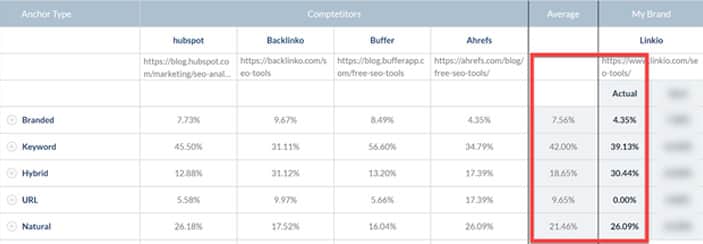
Linkio calculates the average percentages for you and lets you compare them to your current percentages.
It will also crawl and check the index status of every competitor backlink to ensure that the percentages and data are as accurate and up-to-date as possible.
As you can see from the table, in order to get my content ranked, I’ll need to focus on building quite a few URL backlinks to even my percentages out and come closer to my target.
This strategy is a stark departure from the popular SEO prescription to “Just build more keyword anchors” until your content is on the first page.
By leveraging a tool like Linkio, you can create a backlink profile that not only appears natural, but directly mimics the top ranking pages for your target keyword.
If you can use this strategy while simultaneously delivering content that is better than anything else on the first page, you will be set up to take the internet by storm and achieve total SEO domination (queue evil laugh).
Anchor Text Phrases to Use Based on Page Type
Another common pitfall into which many an amateur link builder has fallen is using unnatural anchor text phrases while building links.
If you think back to Linker’s Intent (which we discussed earlier), the anchor text of a real link will vary wildly depending on the type of website and page type to which the link is going.
For example, if an amateur SEO were to attempt to build links to an ecommerce product page that sells water bottles, this is probably what their anchor phrases would look like…
- Water bottles
- Water bottles for sale
- Buy water bottles
- Best water bottles
I’ll be the first to say it… These phrases REEK of Old School SEO strategy.
The simple fact of the matter is that most bloggers would never link back to your content using anchors 2, 3, or 4. These types of phrases can make your anchor text profile maintain a spammy appearance.
Instead, let’s look at this approach:
- Water bottles
- This water bottle here
- like these water bottles
- the water bottle I use
See the differences?
The former anchors are purely commercial whereas the latter seem much more natural and based on real life examples or personal reference.
Based on our research… These are the phrases people actually use to link to a product page.
The same principle applies to the branded and just natural anchor type.
For example, here are real branded anchors for an ecommerce page.
- special deals from the SteeleForce
- this one from SteeleForce
- link to buy it at SteeleForce
- SteeleForce shows ‘in stock’
And here are the correctly used Natural anchors.
- check this out
- sale items
- get one here !
- click to shop
When you start stacking anchor text signals like this, your footprint looks incredibly natural, ensuring that you stay in Google’s good graces and avoid any hefty penalties.
Oh, and I almost forgot to mention…
To make your link building as seamless as possible, I went ahead and built this functionality right into the Linkio software.
This means that you’ll get customized anchor suggestions based on the type of page for which you are trying to build links.
Try it out at https://www.outreachlabs.com/linkio/
Anchor Text Cycling: Building Links in a Natural Pattern
Once you know how many links to build, there’s only one thing left to do…
Going out and building the damn things!
To do this effectively, you’ll want to cycle your link building efforts in the following order to ensure that your link profile appears natural as it’s being built.

According to Nathan Gotch, “The point of anchor text cycling is to spread your exact match anchors out over the course of months. This is much more natural.”
And I have to say… I agree with his approach.
In fact, this is the exact strategy that we used when we first built Linkio.
Here’s a screenshot of the order in which I need to build my anchors to rank my page faster..

As you’ll notice from the image above, the first suggestion Linkio makes is to build a few Natural anchors to help bring the page closer to the ideal percentage (since the target percentage is 16% and the current Natural percentage is.. Well, 0%).
Since this is the biggest gap in the execution of our new strategy, Linkio starts us there.
The rest of the suggestions are merely a natural cycling of anchors to build out the percentages in a random/natural way without getting slapped with an inevitable penalty from over-optimization.
Applying This Knowledge
The concepts that I’ve shared thus far are the keys to mastering anchor text strategy.
If you can fully grasp and internalize what I’ve shared with you today and how the different pieces of this puzzle fit together to form a coherent anchor text strategy, you’ll be able to rank faster, avoid trouble, and eliminate all of the superfluous over optimization that has likely plagued your strategy up until this point.
Before I leave you to it, let me give you one final example to help you visualize what this will look like when it all comes together.
| Page URL | https://www.linkio.com/ | https://www.linkio.com/seo-tools/ | https://www.linkio.com/directory-submission-sites/ |
|---|---|---|---|
| Page Type | Company Homepage | Long-Form Content | Long-Form Content |
| Estimated Number of Links to Build | 2000 (This is a massively competitive industry) | 400 | 5 |
| Description | Already has 200ish of links, mostly branded | Has some links, needs a lot more | No links yet |
| Ideal Percentage Target | National Homepage – No Keyword in Domain Default | Calculated from Competitors | Content Page Default |
| Next 10 Anchors to Build | Naked URL: https://www.linkio.com/ Naked URL: https://www.linkio.com/ Naked URL: https://www.linkio.com/ Naked URL: https://www.linkio.com/ Title Tag: Linkio – seo software – the best seo management tool Just Natural: Read More… Naked URL: https://www.linkio.com/ Title Tag: LINKIO – SEO SOFTWARE – THE BEST SEO MANAGEMENT TOOL Just Natural: Here’s a great place to get started Naked URL: https://www.linkio.com/ | Naked URL: https://www.linkio.com/seo-tools/ Exact Keyword: SEO TOOL WebsiteName.com: www.linkio.com Naked URL: https://www.linkio.com/seo-tools/ Only Part of Keyword: tools to make it easier Naked URL without http://: www.linkio.com/seo-tools/ No Text: [image link] Exact Keyword: seo tool Branded: LINKIO Title Tag: The Definitive SEO Tools and Software List (2018 Update) | Linkio | Keyword Plus Word: a huge directory sites list Exact Keyword: directory submission sites Only Part of Keyword: foundational sites to use Branded: new article from Linkio Naked URL: https://www.linkio.com/directory-submission-sites/ Title Tag: 200 + Directory Submission Sites List for 2019 | Linkio Brand & Keyword Together: Linkio Blog: What are some quality directory submission sites? Just Natural: some ideas Keyword Plus Word: listing your brand on these directory submission sites No Text: [image link] |
Note the vast disparity between each page in the ‘Estimated Number of Links to Build’.
To rank my homepage, I will need more than 2,000 links (and I’m working towards achieving that!). My ‘SEO Tools’ guide, at around 400 required links, needs slightly fewer links. And the directory submission sites page, a rather competitor-free keyword, needs a paltry 5 links.
Understanding these different page types and requirements that will help you get to the first page of Google allows you to prioritize your link building efforts in a way that guarantees that highest ROI at the fastest speed possible.
Using my company as an example, I’d build the 5 links for the directory submissions sites pages first to get those rankings.
Then I’d focus 75% of my energies on building links to the homepage to increase my overall authority and the rest of the SEO tools page.
The reason that I prioritize my homepage over the SEO tools page (even though the SEO tools page technically requires fewer links) is because this shifted focus will help me boost my website’s general authority.
Otherwise, I’ll end up needing to build far too many internal page links for highly competitive terms.
I know this can seem like a lot.
And at this point, you’re head is probably spinning and you might be thinking to yourself, “Jesus, Ajay! Slow down for a minute and let me catch my breath.”
Don’t worry, this guide is meant to be acted upon slowly – over the course of weeks and months – so that you’re following each step to its natural progression and achieving a first page ranking as quickly as possible.
But my greatest hope is that I’ve shifted your paradigm and encouraged you to view link building in a new light.
When you understand the purpose behind the links that you are building everything starts to change.
- Build homepage links to establish thematic relevance and grow your brand’s authority
- Build content links to long form pages to rank for competitive keywords
- And build links to dozens of low competition keywords to get quick wins and achieve higher rankings in the long run.
When you begin to view the pages on your website as a part of a greater whole, each feeding into each other to create a virtuous (or vicious) cycle of SEO success, you’ll eradicate your inclination to engage in blackhat SEO tactics or blast your commercial pages with exact match keyword anchors.
If you can take what I’ve taught you today and run with it, the way that you play the game of SEO will change forever and you will reap the rewards of understanding and being able to offer Google exactly what it wants.
So there you have it!
The ULTIMATE guide to anchor text strategy.
What did you think? Do you have any questions that I didn’t answer? Anything that needs clarification? Let me know in the comments below and I’ll do my best to get back to you!
